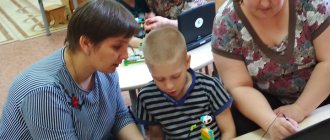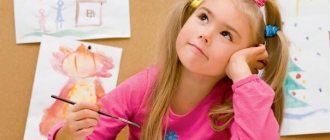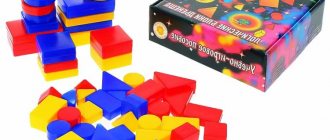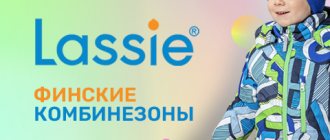The Hungarian psychologist and teacher has developed wonderful exercises and games that promote the development of mathematical concepts, as well as creative and logical thinking. Work on getting to know blocks begins in the second junior group, where kids identify one feature of an object. In the middle group, the tasks become more complicated, symbol cards appear, with the help of which children select the necessary figures. What games can be used with Dienesh blocks in older preschool age?
Dienesha blocks for preschool children
Dienesh blocks look like three-dimensional geometric objects, reminiscent of those from which children usually build houses. However, this is not just a construction set, but material for a whole series of educational and educational games.
The set includes 48 non-repeating shapes. Each object differs from the others in at least one of 4 parameters:
- geometry - circle, square, triangle, rectangle;
- color – red, blue, yellow;
- size – large, small;
- volume - thick, thin.
That is, the set consists of 4 groups of figures of 12 pieces each. Groups of Dienesh blocks allow you to organize many exciting games that teach preschoolers to analyze, compare, generalize, and classify information. The set is supplemented with cards with illustrative, schematic and template images, as well as descriptions of tasks.
Ready-made cards and assignments are in demand; with their help, it is easier for a preschooler to get acquainted with geometric shapes. Based on the schematic image, the child makes a picture. Younger children place blocks directly on the diagram. Older preschoolers lay out the figures next to the schematic image.
The method was invented by educational psychologist Zoltan Dienes. It is an entertaining game form for developing mathematical thinking in children. According to the famous teacher, mastering mathematics is only effective when the child does not get bored. It is difficult for a preschooler to fix information in his mind when he has to listen for a long time and strain his brain. And the game method allows the child to absorb and remember information without stress and fatigue.
The method of teacher Dienesh develops mathematical thinking. For the comprehensive development of a child, it is necessary to use other teaching methods.
Dienesh's method involves 6 learning stages, depending on the age abilities of the children:
- a game without rules - the child learns to work with blocks, he develops mathematical concepts;
- playing by the rules;
- lesson with comparative analysis;
- representation – the child plays in accordance with the proposed methods, focusing on the acquired knowledge;
- creative activities conducted in accordance with logical concepts;
- formalization is that level of classes at which a preschooler is already able to draw conclusions and justifications.
Games with hoops and Dienesha blocks
A special section in Dienesh’s methodology is devoted to games with hoops, which also begin with completing simple tasks and gradually become more complex, allowing the teacher to develop analytical thinking, mental flexibility and speed of reaction in future schoolchildren.
"Game with one hoop"
There is a hoop on the floor. Each child has one block in his hand. Children take turns placing blocks in accordance with the leader’s instructions. For example, inside the hoop are all red blocks, and outside the hoop are all the rest. Children are asked questions: What blocks are inside the hoop? (Reds). Which blocks were outside the hoop? (Non-red). This is the correct answer, because... the only important thing is that all the red blocks are inside the hoop and there are no others there, and the properties of the blocks outside the hoop are determined through the properties of those that lie inside. When repeating the game, children can choose for themselves which blocks to put inside, outside, and then determine to each other in one word the shapes outside the hoop.
"Game with two hoops"
There are two multi-colored hoops on the floor (blue and red), the hoops intersect, so they have a common part. The presenter invites someone to stand inside the blue hoop, inside the red hoop, inside both hoops, outside the red hoop, inside the blue but outside the red, inside the red but outside the blue, outside the blue and red hoops.
Then the children arrange the blocks so that all the round blocks are inside the blue hoop, and all the red ones are inside the red hoop.
At first, the problem is where to put the red and round blocks. Their place is in the common part of the two hoops. After completing the practical task of arranging blocks, children answer four questions:
- What blocks are inside both hoops?
- Inside the blue but outside the red hoop?
- Inside red but outside blue?
- Outside both hoops?
It should be emphasized that the blocks must be named here using two properties - shape and color.
"Game with three hoops"
During the game with three hoops, the task of classifying blocks according to three properties is solved, which is more complex than in the game with two hoops. The presenter places three multi-colored (red, blue, yellow) hoops on the floor as shown in the figure, i.e. to form 8 regions.
Once these areas are named appropriately in relation to the hoops (inside all three hoops, inside red and blue, but outside yellow, etc.), it is proposed to arrange the blocks, for example, so that all the red blocks are inside the red hoop, inside the blue they are all square, and inside the yellow they are all big.
After completing the practical task, children answer eight questions (standard for any version of the game with three hoops).
- What blocks are inside all three hoops?
- What blocks are inside the red and blue hoop, but outside the yellow hoop?
- What blocks are inside the blue and yellow hoop, but outside the red hoop?
- What blocks are inside the red and yellow hoop, but outside the blue hoop?
- What blocks are inside the red hoop, but outside the blue and outside the yellow hoop?
- What blocks are inside the blue hoop but outside the yellow and red hoop?
- What blocks are inside the yellow hoop, but outside the red and outside the blue hoop?
- Which blocks are outside all three hoops?
The game with three hoops models the partition of a set into eight classes (pairwise disjoint subsets) using three properties (being red, being square, being large). [ads2] Games with Dienesh blocks in older preschool age do not require special preparation, you only need to prepare special cards for joint and individual work. You can download an archive with cards for games with Dienesh blocks, which contains symbol cards and negation cards, as well as cards for the games “Guess the Riddle”, “Rest the Tenants”, “Logic Tables” of different difficulty levels.
Goals and objectives
Young children have no problem mastering arithmetic, but they struggle with abstract thinking. When searching for information, a child tends to rely on patterns, but this does not always work out. Dienesh invented a technique through which preschoolers learn about abstract concepts by visualizing them. Dienesh's math blocks are an easy-to-understand and fun way to prepare for school.
The purpose of Dienesh's games is to develop logical and mathematical thinking among kindergarteners and primary schoolchildren.
Tasks:
- training in the skill of analyzing forms, comparing them according to certain parameters;
- creative and intellectual development;
- developing the ability to think logically, build chains of thoughts, and make assumptions;
- formation of responsibility, perseverance, diligence;
- speech development, expansion of individual vocabulary.
The use of Dienesh blocks is relevant in kindergartens and grades 1-2 of primary school. That is, classes are intended for children 2-8 years old.
Lesson program with blocks: goals and objectives for different age groups
The goals of the method for the early development of mathematical abilities by Z. Djeniš:
- Acquaintance with the basic geometric shapes, as well as the concept of a standard form, the formation of the ability to determine the color and size of an object, the development of the concept of set;
- Acquiring primary skills in algorithmic thinking;
- Activation of memory, development of the ability to concentrate and maintain attention, as well as mental processes of imagination and speech;
- Formation of spatial thinking, modeling and design skills;
- Actualization of creative potential;
- Development of an intellectual culture of thinking: the ability to compare, generalize, systematize, carry out independent analysis, understand the meaning of an abstract sign, encode and decipher information, give reasons for your statements.
- Nurturing personal initiative and strong-willed qualities in achieving educational goals, solving practical problems and overcoming obstacles.
Construction will develop imaginative thinking and creative abilities of the child, activates fantasy and imagination.
Features and general rules for using visual aids for each age category:
The ability to determine one property (shape, color, size or thickness).
- The first junior group (2–3 years old) – Z. Dienesh’s blocks are in demand starting from the middle of the school year as an additional element in play activities. The teacher gradually includes blocks, additional diagrams and cards in order to form and consolidate an idea of one property of an object. The acquired skill of operating with a single property of an object is applied not only to the game manual, but also to fairy-tale literary characters, thus expanding the space of game modeling and activating the fantasy and imagination of children. For greater comfort and efficiency of classes, it is recommended to distribute children into small subgroups.
Video: Logical blocks of Dienesh in the first junior group
https://youtube.com/watch?v=yhQVkuDZzFc
Feature matching skills.
- The second younger group (3–4 years old) - the teacher includes the concept of a second qualitative distinctive property; by the end of the school year, children freely distinguish between two properties of an object and its symbolic encrypted image in the form of a card. The ability to read cards containing coded information about the properties of an object develops, and the acquired skills are used in a logic game.
- Middle group (4–5 years old) – over the course of a year, children master the skill of identifying and comparing three characteristics. Gradually, the negative particle “not” is introduced into the speech lexicon. Situations are actively played out when each child is given three symbol cards and asked to select the corresponding logical blocks or figures, which then must be used as building bricks according to a given algorithm of actions, for example, for the joint construction of a building or the construction of a road, playground, etc. .
Improving acquired skills in the context of increasing complexity of tasks for logical operations of systematization and classification.
- Senior and preparatory group (5–7 years old) - the practice of using cards for three properties continues, by the end of the school year the fourth property is introduced. The teacher’s task is to teach children to strictly follow the rules of the game, to consolidate in the child’s mind the understanding that violating the correct sequence will not allow achieving the desired result. The range of gaming exercises becomes more diverse and complex thanks to the use of new didactic tools such as hoops and algorithmic schemes.
Logic cubes, like symbol cards, will help you come up with a variety of games with your children, and these games, in turn, will be useful for mastering the actions of substitution and visual modeling, encoding and decoding
In carrying out the final diagnostics of the success of teaching activities according to the method of Z. Dienesh, one should focus on the following predicted result:
- Pupils improve their communication skills and their desire to cooperate in educational and gaming activities increases.
- Logical thinking develops, the cognitive and creative potential of children is revealed.
- Children show more independence and activity.
- The initial stage of mastering mathematical knowledge is successfully overcome, and interest in this academic discipline is established.
Junior group
For children of a younger age group, primitive games are suitable, in which you need to group and separate objects according to parameters.
Find the same one
The teacher shows the figure. The player must find the same object based on one parameter: geometry or color. For example: a yellow triangle is shown. This means you need to find either red and blue triangles, or other yellow shapes.
Find something different
The opposite of the previous task. It is required to find figures that differ from the demonstrated element in a certain parameter: size, color, geometry.
Plant in the beds
For the game you need to prepare improvised beds. The blocks will be vegetable seeds. The teacher gives the task to plant the seeds in certain beds. For example, for the first bed - small and red, for the second - square and yellow.
Feed the toys
To play, you need to place dolls or soft toys on the table. Dienesh blocks will be food. The teacher explains that toys want to eat, but each of them has its own food. For example, a teddy bear eats large yellow figures, and the Masha doll eats small blue ones. The players’ task is to choose the right blocks for each toy.
Didactic material by Z. Dienesh
Author's logic blocks will introduce your child to the world of shape, color and size during casual mathematical play. The value of the didactic material of Z. Dienis:
- The most important psychological indicators of the development of logic and concentration, imagination, non-standard thinking and memory will receive an additional incentive for development.
- Working with the author's visual aids will develop speech, develop analysis and systematization skills, teach how to summarize information, and reveal the child's creative potential.
Each figure is characterized by four properties. The main goal is to teach the child to solve logical problems involving partitioning by properties
Flat version of Dienesh blocks. The kits can be widely used for: introducing children to standards of forms, teaching actions with standards. Cubes whose sides contain coded properties (shape, color, size, thickness) and the negation of properties (crossed out sign) Cubes whose sides contain properties, negation of properties. as well as numbers from three to eight Cards contain encoded information about the properties of an object The child takes a card with an example, solves it by decoding and selects the corresponding block
Schemes for making cakes The child places the selected block on the diagram with images of objects under the number that he determined as a result of solving the example on the card
The game “find a house for a lost figure”, in some houses one figure can live, in others - several Each ball is selected by solving a symbol card Correct decoding of information will allow you to select the necessary blocks and figures
Each page of the album is an illustration on which the child will have to place blocks of the appropriate color, size and shape according to the example: Option 1 - offer to move one resident into each apartment, Option 2 - two residents into each apartment. You can easily draw such a diagram yourself
This is how you can draw a symbol card by hand
At home, the album can be replaced with regular coloring
Scheme for making logical figures
Parameters of the sides of logical figures
Math blocks
The classic set of teaching blocks includes 48 parts of various colors, sizes and shapes. The elements are made in accordance with the main list of geometric shapes and have the following characteristics:
- Four block shapes: square, round, triangle and rectangle;
- Three color options: blue, red and yellow.
- Two thickness options: thick, thin;
- Two size options: large, small.
It is also fundamentally important that the set does not contain identical geometric blocks.
Video: Gyenes Logic Blocks
https://youtube.com/watch?v=CV_PU3fUuf0
Logical figures
One set for organizing classes in a small subgroup contains 24 flat figures, which include an equal number (6 elements each) of squares, triangles, rectangles and circles, as well as blocks of different colors (red, yellow, blue) and size (large, small). A visual aid with logical figures is necessary for working with the concept of a form standard and learning to manipulate standards.
Logic cubes
Cubes, the sides of which contain a coded image of characteristics (shape, color, size, thickness) and the negation of properties (a crossed out sign), as well as a cube with numbers from three to eight on each side. This didactic material is important for mastering the mental operations of substitution, symbolic encryption, decoding, and spatial modeling. The originality of logic cubes lies in the variability of the spontaneous choice of properties, which is made by tossing the cube, and this always causes delight and interest in children.
To complete the task, the child must master the skills of decoding the symbols depicted on the faces of the logic cube
Cards with symbolic transmission of information about the properties of an object, as well as arithmetic examples.
- It will help the child to master the cultural tradition of symbolic, encoded in a symbol, transmission of information about the characteristics of an object.
- Will develop the ability to perform abstract mental operations and decipher symbols.
- Builds mental arithmetic skills.
Albums, algorithmic schemes
The goal is to teach the child to strictly follow the rules and strictly follow the prescribed sequence of steps. Schematically indicate the path that needs to be taken to solve the problem.
Ribbons or hoops can serve as additional didactic tools for defining the playing area; with their help, you can expand the range of exercise options, make them more varied and exciting.
Do-it-yourself materials by Z. Dienis
Most of the games can be played using flat figures, and they can be cut out of cardboard, colored paper, painted with colored pencils or paints; variants of card schemes can also be invented independently, by analogy with ready-made ones, and drawn by hand. If it is difficult to find sets of additional cards or albums on sale, then you can print algorithmic or digital cards or album options on a color printer.
Each page of the album is an illustration on which the child will have to place blocks of the appropriate color, size and shape according to the pattern. The pictures are structured according to the principle “from simple to complex” - at the beginning there are pictures consisting of a minimum number of details
Middle group
Middle age preschoolers can play with diagrams and pictures. It is advisable to choose creative games with Dienesh blocks so that students use their imagination as much as possible.
Game with pictures
To play, you need to buy or print color pictures depicting different objects in a geometric representation. The child’s task is to correctly place the blocks on the picture. For example, the car wheel shown is a circle. This means you need to apply a round block.
Build a row
The game greatly develops the ability to analyze.
You need to place several blocks so that a clear sequence is formed. The player must understand which piece to place next. For example, a red circle followed by a blue one. Therefore, the third one will be the yellow circle. Or this combination: circle, square, triangle - all red. This means that the fourth figure will be a red rectangle.
What's extra
The game teaches you to group objects according to certain characteristics.
The teacher lays out 3 or 4 figures in front of the child. One should be superfluous, that is, not having a single common feature with the others. The player must point to the wrong object and explain his decision.
When the child begins to cope with it with ease, complicate the task: put 6 figures, of which two should be incorrect.
Point to an object with "not"
The teacher lays out the blocks and names signs with negation. And children must point to the corresponding objects. For example, “this figure is not red” or “this is not a triangle.”
Fix the bridge
To play, you need to prepare cards depicting geometric shapes, indicating their colors and sizes. And also similar cards, but with crossed out images, meaning that the block should not have such signs.
The teacher tells a story about how a bridge broke between the houses of two fairy-tale characters, and the neighbors can no longer see each other. The students' task is to repair the bridge. Only the “bricks” need to be laid not at random, but according to a certain rule, then the structure will be strong and will no longer break.
Next, the teacher shows 1-2 cards with parameters, and the children choose the appropriate “bricks”. For example, cards are shown with a crossed out triangle and an uncrossed red color. This means that the next “brick” for the bridge must be red, but cannot be a triangle.
Which figure disappeared
The game strengthens memory and concentration.
The teacher lays out several blocks in a row. The child tries to remember the sequence, then closes his eyes. The teacher removes one element of the sequence. The pupil, having opened his eyes, must remember what figure was in the place where it is now empty.
The game can be a little more complicated: do not leave an empty space, but replace the removed block with another. Then the player’s task becomes to return a number of figures to their original form. If the child copes well, you can complicate it even more: replace not one, but 2-3 objects.
Constructor
Children love to play with Dienesh blocks as if they were construction sets. This game develops imagination and creative thinking.
Children construct something at the suggestion of the teacher or at their own request. To begin, have students practice constructing using a visual diagram. Then they must use their imagination.
MAGAZINE Preschooler.RF
Summary of GCD on FEMP using Dienesh logic blocks in the senior groupGoal: creating conditions for the formation of elementary mathematical concepts.
Tasks:
Educational:
Form elementary mathematical concepts:
- teach children to compare objects and geometric shapes based on two or more properties:
- practice ordinal and quantitative counting within 10;
- develop the ability to compare objects using measurements;
- form ideas about space (right, left) and time (days of the week, time of day);
Educational:
Develop primary techniques of logical thinking (form the ability to observe, compare, generalize, classify) develop speech as a means and form of mental activity.
Educational:
To cultivate curiosity and interest in travel as a form of learning about the world around us.
Materials and equipment: bi-ba-bo doll Parsley; train tickets by number of children; ball; Dienesha blocks; cards with encodings for Dienesh blocks.
GCD move:
1 part. Introductory and motivational.
Educator: Today, guys, a package arrived at our kindergarten. I wonder what's in it? (The teacher takes out Parsley and a letter with a riddle).
Parsley:
I am not a simple boy. Curious, mischievous. I want to catch everything, find out. Will you play with me?
Educator: If only you could play, parsley. It is very important to study in order to know and be able to do a lot.
Parsley: I already know everything.
Educator: Then help me guess the riddle. And you guys, listen carefully:
“She will teach you to never be bored and to distinguish shapes, numbers, and colors, to solve problems and to count objects
But what can we call it in one word?
Parsley: Well, no, I don’t know that.
Educator: Then I invite you guys to go on an interesting journey: complete different tasks, play and find out the correct answer to the riddle. Do you want to go on a trip?
Part 2. Main.
Look at the unusual train - let's eat on it. (train carriages are children's chairs with geometric shapes attached to them)
To get a ticket, give the correct answer:
— Count how many trailers there are in total?
— What shape is the first trailer? 3rd?
— What kind of round carriage is it?
— What shape is the carriage between 1st and 3rd?
Well done! Get a ticket and take a seat in a carriage of the same shape.
(The teacher puts on a conductor’s cap)
Educator: Attention! Ticket check!
— What color is your ticket?
— What form is your ticket?
— Show only blue tickets.
The children are seated.
While the children are traveling, you can play any speech game on the theme of a train.
The whistle blows.
Parsley: Why did you stop?
Educator: Fork in the road. (Arrows to the right and left. Two tracks: right wide, left narrow)
— What direction does this arrow point? What about the other one?
- Which track should we take? Are they the same or different?
- How to check?
Children compare the width of the track with a measuring stick.
Educator: What gauge is suitable in width for our train?
Children measure the makeshift train wheels and find out what width of track is appropriate.
- So, which way should we go next?
Children stand one after another like a train. Dynamic pause.
Educator: Lesnaya . Go out to the edge, look, and a wise owl is waiting for us on the tree. She knows all the numbers, do you know?
Children I think. Direct and reverse counting.
Educator: Guys, look, mushrooms, berries, and flowers grow in this clearing. They do not grow separately, but together, in groups. Find a group of objects in the clearing that correspond in number to the number 3? 5? (The teacher checks the correctness of the answers).
Parsley: Let's play! Stand in a circle, play with the ball “Name the days of the week” , “Time of day” .
Educator: Time for work, time for fun! A hedgehog lives in a forest clearing. And he asks for our help. We need to help him collect only edible mushrooms in the basket. The hedgehog will give you a hint on how to identify an edible mushroom.
The task is performed with Dienesh blocks. Children are given cards with encoding figures. Children “read” the coding and find the block they need (an edible mushroom) and put it in the hedgehog’s basket.
Parsley: We've been walking through the forest for so long, we're probably all hungry. Let's treat our animals to something?!
Educator: Oh! While we were on the train, we walked along the paths of the fairytale forest - all the treats were mixed. Let's figure out what we have in the bucket here? Who should I treat with what?
Part 3. Reflective.
Educator: Maybe now you can guess what the riddle was about (reads again).
If the children find it difficult, they remind them: Where were we today and what did we do?
What helped us cope with all the tasks? Knowledge of Mathematics.
Educator: Well done, guys! Now Petrushka and I will reward you with the best grade they give at school.
The teacher gives the children medallions with the number five.
Didactic game for older preschoolers in two versions:
- to solve mathematical examples;
- using Dienesh logic blocks.
Game plot: One day a hurricane hit the land of fairy-tale heroes. Strong winds tore off numbers from all houses. And now postmen cannot deliver correspondence to the required address. The pig Naf-Naf is waiting for a telegram from his brother, the frog is waiting for a congratulation from the mouse - Narushki, and the cat Matroskin is waiting for a parcel from Uncle Fyodor. But postman Pechkin alone cannot manage to deliver letters and postcards on time. Let's, guys, help the postmen deliver letters and telegrams to their recipients. In order for mail to be delivered correctly, certain conditions must be met.
Game material: pictures depicting houses, mail, postman Pechkin; cards with mathematical examples of addition and subtraction and cards with coding schemes for block properties.
Educational and game tasks:
- Learn to visually solve simple addition and subtraction problems. When solving problems, learn to use plus and minus signs;
- Develop the ability to replace and model the properties of objects using schemes for encoding and decoding them;
- Develop logical thinking;
- Foster independence in decision making.
There are pictures of houses on the magnetic board. One house is a post office, next to it stands the postman Alexander Ivanovich Pechkin. The rest of the houses: Naf-Nafa, a teremok, a house from the village of Prostokvashino. Under the houses there are cards with mathematical examples, after deciding which children will determine the number (address) of the house, similarly the post office number.
Let's play! We think! Postman Pechkin will deliver the letter to the house whose number does not match (different) with the post office number. And to do this, to find out the house number, you need to solve the example, the result is the number. All that remains is to compare the house and post office numbers, and an envelope is attached to the desired address. The conditions can be changed at the request of the teacher.
To play the second version of the game, you need a set of “Dienesh Logic Blocks”
The conditions will be as follows: Postman Pechkin will deliver the letter to the house whose house number matches the post office number. And the house number is indicated by a block, which is encoded in the card diagram. There can be a coincidence or a discrepancy based on one, two, or three characteristics, depending on the children’s ability to use the blocks.
Planned result:
- Children will cope with tasks in games with Dienesh blocks.
- Do creative work.
Further work:
- Continue to develop the ability to operate with 4 properties in games with Dienesh blocks and write a code indicating the negation sign “not” (not a square, which means a circle or triangle).
- Continue to promote the formation of a motive for cognitive activity in children.
| Next > |
Senior group
Dienesh's logic blocks help kindergarteners preparing for school to improve their math skills. Children learn to count, compare, and contrast.
House
To play, draw a diagram of a house. In every room there lives a geometric figure, you need to draw it there. Certain blocks should not live in some rooms; crossed out figures should be drawn there. The pupils’ task is to correctly distribute the blocks among the rooms.
Shop
Make a makeshift store for the game. Let the goods be toys, treats, and stationery. And money is Dienesh’s blocks.
The teacher distributes blocks to the children. Then he says which product costs how much. For example, for a teddy bear you need to pay two triangles. A child, looking at his “money,” understands whether he can afford to buy this product.
Price requirements should gradually become more complex. First, the colors of the blocks are added to the price, then the sizes. For example, “for a doll you need to pay a blue rectangle” or “a box of pencils costs two large circles of yellow and red colors.”
Domino
Blocks are distributed equally between players. The first participant, chosen by lot, places a piece on the table. The next player must place a block that matches the first one in one of the indicators: color, shape or size. If there is no such block, you will have to skip a move. The winner is the player who gets rid of all his pieces first.
Christmas tree
The game develops the skill of counting in order and navigating through schematic images. For this lesson you need to prepare a picture of a Christmas tree and 15 character cards. Dienesh blocks will be Christmas balls.
To decorate the spruce, 15 balls are used: 5 rows of 3 pieces. On the cards, numbers indicate row numbers, and one of the 3 circles filled in indicates the location of the ball in the row. At the bottom of the picture it is indicated which geometric figure will represent a particular Christmas ball.
Find the treasure
The teacher places blocks in front of the player. The child turns away so that the teacher can hide a coin under one of the laid out objects. To find the treasure, the player asks questions. For example: “Treasure under the red block?” The presenter answers: “No.” This means that red objects are excluded; there is no coin under them. Next: “Treasure under the round block?” Host: “Yes.” This means you need to look among the round shapes. And so on until the treasure is found. Having found the treasure, the player himself becomes the leader, hiding the coin for another participant.
Gifts for animals
To play, you need to place three hula hoops on the floor so that they intersect. Next to each circle, plant a soft toy, for example, a bunny, a bear, or a fox.
The teacher explains to the students that the animals quarreled over the gifts and cannot share them. The bunny wants small ones, the fox wants triangular ones, and the bear cub wants fat ones. Only some gifts are small, triangular, and thick. Because of them, the animals argue. The children’s task is to distribute the blocks so that the controversial ones lie at the intersections of the hula hoops.
Journey
For an exciting game, you need to prepare the playing field: there is one start, then the path branches into many paths. At the beginning of each path there should be a road sign indicating which block can follow it. If the block is prohibited from passing, it will have to take another path.
For example, at first the road splits in two: large blocks go along the left branch, small blocks go along the right. Next comes the branching by color. It is advisable that at the end of each path some interesting place is drawn - the final goal of the trip: a school, a cafe, a beach, a store, a pharmacy.
What are Dienes blocks
This is the name of a special didactic manual for mastering mathematics, developed by a famous Hungarian scientist.
Zoltan Gyenes devoted his entire life to this discipline. He tried to make it as understandable and interesting as possible for children. For this purpose, he specially developed the author's Dienesh system for the early development of mathematics by children. The game manual is a set of 48 geometric shapes. They are represented by elements, among which there are no repetitions. The figures are divided according to the following criteria:
- Color. Blue, red, yellow.
- Size. Small, big.
- Thickness. Thick, thin.
- Form. Circle, triangle, square, rectangle.






